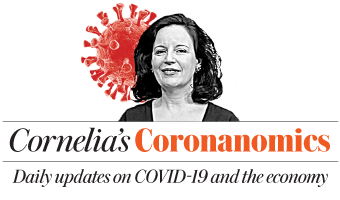What happened:
Markets were moderately up yesterday, and the risk sentiment continued for European stock markets into Tuesday.
The WHO said that the coronavirus disease (COVID-19) outbreak may be nearing its peak in Europe. This shifted the conversation from stimulus packages to where the global economy will be headed after the impact of the pandemic abates.
President of the St. Louis Federal Reserve James Bullard told Bloomberg that the US had debt capacity beyond the stimulus. He also cautioned that the US might see unemployment rise to 30 percent.
As China returns to work, the Purchasing Manager’s Index (PMI) rose to 52 in March. It is too early to be jubilant because the March PMI follows on that of February, which stood at 35.7. January and February also saw a 17 percent decline of exports year on year. Expect that number to worsen, as most of China’s export markets halted economic activity. The GDP of the world’s second largest economy is expected to fall for the first time since 1976.

Why it happened:
Black Rock’s Larry Fink thinks that markets have seen their lows, but that after the worst is over the global economy will look different. Investor sentiment, business practices and consumer sentiments will be reshaped substantially. This will have an impact on interconnectivity and supply chains. Morgan Stanley and JPMorgan also estimate that markets have reached their lows. Many disagree.
Volatility was immense since the outbreak. At the beginning of the month, the volatility index reached 85 — the highest in history. While oscillating, it came down, but it still stands above 65. When volatility is up, investors flock to safe havens.
The dollar saw big inflows, which abated somewhat when the $2 trillion package was announced. The Swiss franc and the yen, which are traditional safe havens, also saw big inflows. CNBC reported that the Swiss National Bank doubled its open market operations for 2020 to SFr 12 billion.

Ten-year US treasury yields fluctuated on a downward trajectory. Gold surged at the beginning of the month and dipped later because investors were in securities, such as exchange-traded funds. Access to the physical commodity was restricted amid the lockdown. It has recovered since then, standing at $1,640.65 per ounce mid-morning in Europe.

Where we go from here:
There is discussion on the shape of the recovery: V, U or L. Recovery may look different country to country depending on how strong the economy was going into the crisis and how well equipped its private and public sectors were at dealing with the impact. In all probability, U-shaped recoveries will be most prevalent, the question being the depth of the valley.

On a different note, as oil had its worst quarter in history, Saudi Aramco vouched to stand behind its $75 billion dividend commitment. The first instalment for its $70 billion purchase of SABIC is also due. Bloomberg reported that Aramco is considering to raise $10 billion by selling a stake in its pipeline unit.
— Cornelia Meyer is a Ph.D.-level economist with 30 years of experience in investment banking and industry. She is chairman and CEO of business consultancy Meyer Resources.
Twitter: @MeyerResources














